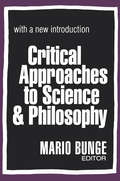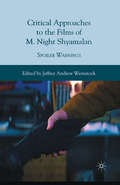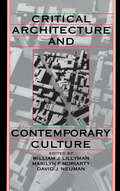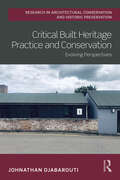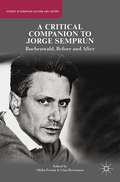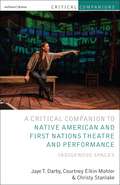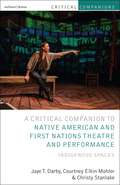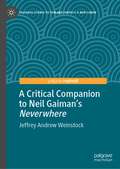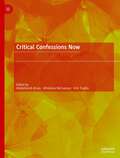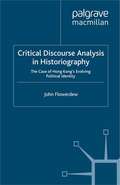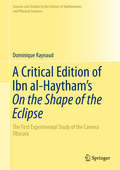- Table View
- List View
Critical Approaches to Science and Philosophy
by Mario BungeThis collection of essays, written on four continents by scientists, philosophers and humanists, was initially presented to Karl R. Popper on his sixtieth birthday as a token of critical admiration and in recognition of his work. But the volume also stands on its own as a remarkable series of statements utilizing Popper's critical vision in the study of philosophy proper, logic, mathematics, science as method and theory, and finally to the study of society and history. What is remarkable is that Popper worked in all of these areas, not in a cursory or discursive way, but with the utmost clarity and rigor.. The core position of this volume and its contributors is that the progress of knowledge is not a linear accumulation of definitive acquisitions but a zigzagging process in which counterexamples and unfavorable evidence ruin generalizations and prompt the invention of more comprehensive and sometimes deeper generalizations, to be criticized in their turn. A critical approach to problems, procedures, and results in every field of inquiry is therefore a necessary condition for the continuance of progress.The title of this volume then is, in a sense, an homage to Popper's critical rationalism and critical empiricism. The essays are a tribute to his unceasing and uncompromising quest, not for final certainty, but for closer truth and increased clarity. Among the contributors are outstanding figures in philosophy and the exact sciences in their own right, including Herbert Feigl, R. M. Hare, J.O. Wisdom, Nicholas Rescher, David Bohm, Paul K. Feyerabend, F. A. Hayek, and Adolf Grunbaum. Social science contributions include Hans Albert on social science and moral philosophy, W. B. Gallie, on the critical philosophy of history, Pieter Geyl on The Open Society and its Enemies, and George H. Nadel on the philosophy of History.
Critical Approaches to the Films of M. Night Shyamalan: Spoiler Warnings
by Jeffrey Andrew WeinstockCritical Approaches to the Films of M. Night Shyamalan represents the first serious academic engagement with auteur director M. Night Shyamalan and his work. The essays, including contributions from established film scholars David Sterritt, Murray Pomerance, Emmanuel Burdeau, R. Barton Palmer, Matt Hills, and Katherine Fowkes, explore the Hollywood blockbusters from The Sixth Sense to The Happening in terms of their themes, aesthetics, and marketing. Taken together, the collection recognizes and explores Shyamalan s "star status" and offers the concerted analysis that this cultural phenomenon requires.
Critical Approaches to the History of Western Herbal Medicine: From Classical Antiquity to the Early Modern Period
by Susan Francia Anne StobartWhy has the history of Western herbal medicine received such little research coverage in any systematic and authoritative way, even though it has figured large in both lay and learned healthcare of the past? What methods and sources are most appropriate for the study of medicinal herbs and herbal practices of the past? This collection provides historians with a coherent guide to a variety of sources in relation to medicinal plants that they have thus far lacked.Critical Approaches to the History of Western Herbal Medicine encourages a serious re-assessment of research in the history of herbal medicine and provides examples of appropriate methodologies and critical examinations of relevant sources. In this innovative collection, historians and researchers from a range of disciplines come together to share material on the identification and use of medicinal plants, the activities of people involved with herbal medicine and the investigation of past herbal therapeutic beliefs and practice. Classical and medieval scholars, social and literary historians, archaeologists and ethnobotanists all contribute to this exploration of the history of Western herbal medicine.
Critical Approaches to the History of Western Herbal Medicine: From Classical Antiquity to the Early Modern Period
by Susan Francia Anne StobartWhy has the history of Western herbal medicine received such little research coverage in any systematic and authoritative way, even though it has figured large in both lay and learned healthcare of the past? What methods and sources are most appropriate for the study of medicinal herbs and herbal practices of the past? This collection provides historians with a coherent guide to a variety of sources in relation to medicinal plants that they have thus far lacked.Critical Approaches to the History of Western Herbal Medicine encourages a serious re-assessment of research in the history of herbal medicine and provides examples of appropriate methodologies and critical examinations of relevant sources. In this innovative collection, historians and researchers from a range of disciplines come together to share material on the identification and use of medicinal plants, the activities of people involved with herbal medicine and the investigation of past herbal therapeutic beliefs and practice. Classical and medieval scholars, social and literary historians, archaeologists and ethnobotanists all contribute to this exploration of the history of Western herbal medicine.
Critical Approaches to TV and Film Set Design
by Geraint D'ArcyThe analysis of scenic design in film and television is often neglected, with visual design elements relegated to part of the mise-en-scène in cinema or simply as "wallpaper" in television. Critical Approaches to TV and Film Set Design positions itself from the audience perspective to explore how we watch TV and film, and how set design enhances and influences the viewing experience. By using semiotics, history and narratology and adding concepts drawn from art, architecture and theatre, Geraint D’Arcy reworks the key concepts of set design. Looking at the impact of production design on how the viewer reads film and television, these updated theories can be applied more flexibly and extensively in academic criticism. D’Arcy creates a new theoretical approach, representing a significant expansion of the field and filling the remaining gaps. This book is ideal for anyone interested in understanding how we can read and interpret design in film and television, and should be the primary point of reference for those studying TV and film set design.
Critical Approaches to TV and Film Set Design
by Geraint D'ArcyThe analysis of scenic design in film and television is often neglected, with visual design elements relegated to part of the mise-en-scène in cinema or simply as "wallpaper" in television. Critical Approaches to TV and Film Set Design positions itself from the audience perspective to explore how we watch TV and film, and how set design enhances and influences the viewing experience. By using semiotics, history and narratology and adding concepts drawn from art, architecture and theatre, Geraint D’Arcy reworks the key concepts of set design. Looking at the impact of production design on how the viewer reads film and television, these updated theories can be applied more flexibly and extensively in academic criticism. D’Arcy creates a new theoretical approach, representing a significant expansion of the field and filling the remaining gaps. This book is ideal for anyone interested in understanding how we can read and interpret design in film and television, and should be the primary point of reference for those studying TV and film set design.
Critical Architecture And Contemporary Culture
by William J. Lillyman Marilyn F. Moriarty David J. NeumanCritical Architecture and Contemporary Culture (University of California Humanities Research Institute Series)
by William J. Lillyman Marilyn F. Moriarty David J. NeumanThe third volume in the University of California Humanities Research Institute Series, this book brings together prominent literary theorists and architects to offer a variety of perspectives on the relation between postmodernism and architecture. The contributors include such luminaries from the forefront of literary studies as J. Hillis Miller, Jacques Derrida, and Jean-Francois Lyotard; the architects Peter Eisenman, Frank Gehry, and Robert Stern offer their perspectives on the critical role of architecture and contemporary culture. The high caliber of the discourse and the variety of approaches included will draw a scholarly audience from a wide range of disciplines.
Critical Built Heritage Practice and Conservation: Evolving Perspectives (Routledge Research in Architectural Conservation and Historic Preservation)
by Johnathan DjabaroutiCritical Built Heritage Practice and Conservation - Evolving Perspectives supports an alternative point of departure for engaging with the historic built environment, by critically questioning the legitimacy of dominant conservation concepts and methods that are often taken for granted within building conservation, architecture, and adaptive reuse. The meaning of heritage is changing. From pastness to presentness, from preservation to participation, and from tangible to intangible, heritage is increasingly understood as a dynamic, social, and intangible process across many disciplines. Consequently, the role and remit of the built heritage practitioner – and in particular the architectural conservationist – is becoming progressively complex and in need of a critical gaze. Is restoration really a falsehood from beginning to end? Should the condition of existing materials determine the conservation method? Is authenticity really an inherent quality within old buildings? By engaging with a critical interpretation of heritage, this book makes space for practitioners to consider the evolution of their own role within a rapidly changing context of built heritage practice. Reinforced by a shift in emphasis from materials to meanings, a ‘socio-material outlook’ is proposed which champions an enhanced focus on intangible heritage within the built heritage sector, whilst still acknowledging the physical condition of old buildings is a priority for many stakeholders. This book has been written with practitioners, students, and educators of architectural conservation in mind – although will also be of relevance to the broader built heritage industry; as well as academics, researchers, and heritage students with a passion for contemporary dialogues in heritage studies.
Critical Built Heritage Practice and Conservation: Evolving Perspectives (Routledge Research in Architectural Conservation and Historic Preservation)
by Johnathan DjabaroutiCritical Built Heritage Practice and Conservation - Evolving Perspectives supports an alternative point of departure for engaging with the historic built environment, by critically questioning the legitimacy of dominant conservation concepts and methods that are often taken for granted within building conservation, architecture, and adaptive reuse. The meaning of heritage is changing. From pastness to presentness, from preservation to participation, and from tangible to intangible, heritage is increasingly understood as a dynamic, social, and intangible process across many disciplines. Consequently, the role and remit of the built heritage practitioner – and in particular the architectural conservationist – is becoming progressively complex and in need of a critical gaze. Is restoration really a falsehood from beginning to end? Should the condition of existing materials determine the conservation method? Is authenticity really an inherent quality within old buildings? By engaging with a critical interpretation of heritage, this book makes space for practitioners to consider the evolution of their own role within a rapidly changing context of built heritage practice. Reinforced by a shift in emphasis from materials to meanings, a ‘socio-material outlook’ is proposed which champions an enhanced focus on intangible heritage within the built heritage sector, whilst still acknowledging the physical condition of old buildings is a priority for many stakeholders. This book has been written with practitioners, students, and educators of architectural conservation in mind – although will also be of relevance to the broader built heritage industry; as well as academics, researchers, and heritage students with a passion for contemporary dialogues in heritage studies.
Critical by Design?: Genealogies, Practices, Positions (Design #57)
by Claudia Mareis Moritz Greiner-Petter Michael RennerIn its constructive and speculative nature, design has the critical potential to reshape prevalent socio-material realities. At the same time, design is inevitably normative, if not often violent, as it stabilises the past, normalises the present, and precludes just and sustainable futures. The contributions rethink concepts of critique that influence the field of design, question inherent blind spots of the discipline, and expand understandings of what critical design practices could be. With contributions from design theory, practice and education, art theory, philosophy, and informatics, »Critical by Design?« aims to question and unpack the ambivalent tensions between design and critique.
A Critical Companion to Jorge Semprún: Buchenwald, Before and After (Studies in European Culture and History)
by Ofelia Ferrán Gina HerrmannPresenting the first English-language collection of essays on Jorge Semprún, this volume explores the life and work of the Spanish Holocaust survivor, author, and political activist. Essays explore his cultural production in all its manifestations, including the role of testimony and fiction in representations of the Holocaust.
Critical Companion to Native American and First Nations Theatre and Performance: Indigenous Spaces (Critical Companions)
by Jaye T. Darby Courtney Elkin Mohler Christy StanlakeThis foundational study offers an accessible introduction to Native American and First Nations theatre by drawing on critical Indigenous and dramaturgical frameworks. It is the first major survey book to introduce Native artists, plays, and theatres within their cultural, aesthetic, spiritual, and socio-political contexts. Native American and First Nations theatre weaves the spiritual and aesthetic traditions of Native cultures into diverse, dynamic, contemporary plays that enact Indigenous human rights through the plays' visionary styles of dramaturgy and performance. The book begins by introducing readers to historical and cultural contexts helpful for reading Native American and First Nations drama, followed by an overview of Indigenous plays and theatre artists from across the century. Finally, it points forward to the ways in which Native American and First Nations theatre artists are continuing to create works that advocate for human rights through transformative Native performance practices.Addressing the complexities of this dynamic field, this volume offers critical grounding in the historical development of Indigenous theatre in North America, while analysing key Native plays and performance traditions from the mainland United States and Canada. In surveying Native theatre from the late 19th century until today, the authors explore the cultural, aesthetic, and spiritual concerns, as well as the political and revitalization efforts of Indigenous peoples. This book frames the major themes of the genre and identifies how such themes are present in the dramaturgy, rehearsal practices, and performance histories of key Native scripts.
Critical Companion to Native American and First Nations Theatre and Performance: Indigenous Spaces (Critical Companions)
by Jaye T. Darby Courtney Elkin Mohler Christy StanlakeThis foundational study offers an accessible introduction to Native American and First Nations theatre by drawing on critical Indigenous and dramaturgical frameworks. It is the first major survey book to introduce Native artists, plays, and theatres within their cultural, aesthetic, spiritual, and socio-political contexts. Native American and First Nations theatre weaves the spiritual and aesthetic traditions of Native cultures into diverse, dynamic, contemporary plays that enact Indigenous human rights through the plays' visionary styles of dramaturgy and performance. The book begins by introducing readers to historical and cultural contexts helpful for reading Native American and First Nations drama, followed by an overview of Indigenous plays and theatre artists from across the century. Finally, it points forward to the ways in which Native American and First Nations theatre artists are continuing to create works that advocate for human rights through transformative Native performance practices.Addressing the complexities of this dynamic field, this volume offers critical grounding in the historical development of Indigenous theatre in North America, while analysing key Native plays and performance traditions from the mainland United States and Canada. In surveying Native theatre from the late 19th century until today, the authors explore the cultural, aesthetic, and spiritual concerns, as well as the political and revitalization efforts of Indigenous peoples. This book frames the major themes of the genre and identifies how such themes are present in the dramaturgy, rehearsal practices, and performance histories of key Native scripts.
A Critical Companion to Neil Gaiman's "Neverwhere" (Palgrave Science Fiction and Fantasy: A New Canon)
by Jeffrey Andrew WeinstockFantasy author Neil Gaiman’s 1996 novel Neverwhere is not just a marvelous self-contained novel, but a terrifically useful text for introducing students to fantasy as a genre and issues of adaptation. Jeffrey Andrew Weinstock’s briskly written A Critical Companion to Neil Gaiman’s Neverwhere offers an introduction to the work; situates it in relation to the fantasy genre, with attention in particular to the Hero’s Journey, urban fantasy, word play, social critique, and contemporary fantasy trends; and explores it as a case study in transmedial adaptation. The study ends with an interview with Neil Gaiman that addresses the novel and a bibliography of scholarly works on Gaiman.
A Critical Companion to the American Stage Musical (Critical Companions)
by Elizabeth L. Wollman Kevin J. Wetmore Jr. Patrick LonerganThis Critical Companion to the American Stage Musical provides the perfect introductory text for students of theatre, music and cultural studies. It traces the history and development of the industry and art form in America with a particular focus on its artistic and commercial development in New York City from the early 20th century to the present. Emphasis is placed on commercial, artistic and cultural events that influenced the Broadway musical for an ever-renewing, increasingly broad and diverse audience: the Gilded Age, the Great Depression, the World War II era, the British invasion in the 1980s and the media age at the turn of the twenty-first century. Supplementary essays by leading scholars provide detailed focus on the American musical's production and preservation, as well as its influence on daily life on the local, national, and international levels. For students, these essays provide models of varying approaches and interpretation, equipping them with the skills and understanding to develop their own analysis of key productions.
A Critical Companion to the American Stage Musical (Critical Companions)
by Elizabeth L. Wollman Kevin J. Wetmore Jr. Patrick LonerganThis Critical Companion to the American Stage Musical provides the perfect introductory text for students of theatre, music and cultural studies. It traces the history and development of the industry and art form in America with a particular focus on its artistic and commercial development in New York City from the early 20th century to the present. Emphasis is placed on commercial, artistic and cultural events that influenced the Broadway musical for an ever-renewing, increasingly broad and diverse audience: the Gilded Age, the Great Depression, the World War II era, the British invasion in the 1980s and the media age at the turn of the twenty-first century. Supplementary essays by leading scholars provide detailed focus on the American musical's production and preservation, as well as its influence on daily life on the local, national, and international levels. For students, these essays provide models of varying approaches and interpretation, equipping them with the skills and understanding to develop their own analysis of key productions.
Critical Confessions Now
This book is based on the postmedieval journal special issue Critical Confessions Now. These chapters on confessions exhibit great diversity and take up different disciplinary approaches by scholars who stand at various stages of their careers. They address not only different time periods but also various linguistic and cultural contexts. Contributors deploy a wide array of methods, critical approaches, and narrative voices, and contributors assumed the confessional voice with a whole host of affective responses — from enthusiasm to cautious hesitation to outright discomfort. Previously published in postmedieval Volume 11, issue 2-3, August 2020.
Critical Design in Context: History, Theory, and Practices
by Matt MalpassCritical Design is becoming an increasingly influential discipline, affecting policy and practice in a range of fields. Matt Malpass's book is the first to introduce critical design as a field, providing a history of the discipline, outlining its key influences, theories and approaches, and explaining how critical design can work in practice through a range of contemporary examples. Critical Design moves away from traditional approaches that limit design's role to the production of profitable objects, focusing instead on a practice that is interrogative, discursive and experimental. Using a wide range of examples from contemporary practice, and drawing on interviews with key practitioners, Matt Malpass provides an introduction to critical design practice and a manifesto for how a radical and unorthodox practice might provide design answers in an age of austerity and ecological crisis.
Critical Design in Context: History, Theory, and Practices
by Matt MalpassCritical Design is becoming an increasingly influential discipline, affecting policy and practice in a range of fields. Matt Malpass's book is the first to introduce critical design as a field, providing a history of the discipline, outlining its key influences, theories and approaches, and explaining how critical design can work in practice through a range of contemporary examples. Critical Design moves away from traditional approaches that limit design's role to the production of profitable objects, focusing instead on a practice that is interrogative, discursive and experimental. Using a wide range of examples from contemporary practice, and drawing on interviews with key practitioners, Matt Malpass provides an introduction to critical design practice and a manifesto for how a radical and unorthodox practice might provide design answers in an age of austerity and ecological crisis.
Critical design in Japan: Material culture, luxury, and the avant-garde (Studies in Design and Material Culture)
by Ory BartalThis book tells the story of critical avant-garde design in Japan, which emerged during the 1960s and continues to inspire designers today. The practice communicates a form of visual and material protest drawing on the ideologies and critical theories of the 1960s and 1970s, notably feminism, body politics, the politics of identity, and ecological, anti-consumerist and anti-institutional critiques, as well as the concept of otherness. It also presents an encounter between two seemingly contradictory concepts: luxury and the avant-garde. The book challenges the definition of design as the production of unnecessary decorative and conceptual objects, and the characterisation of Japanese design in particular as beautiful, sublime or a product of ‘Japanese culture’. In doing so it reveals the ways in which material and visual culture serve to voice protest and formulate a social critique.
Critical design in Japan: Material culture, luxury, and the avant-garde (Studies in Design and Material Culture)
by Ory BartalThis book tells the story of critical avant-garde design in Japan, which emerged during the 1960s and continues to inspire designers today. The practice communicates a form of visual and material protest drawing on the ideologies and critical theories of the 1960s and 1970s, notably feminism, body politics, the politics of identity, and ecological, anti-consumerist and anti-institutional critiques, as well as the concept of otherness. It also presents an encounter between two seemingly contradictory concepts: luxury and the avant-garde. The book challenges the definition of design as the production of unnecessary decorative and conceptual objects, and the characterisation of Japanese design in particular as beautiful, sublime or a product of ‘Japanese culture’. In doing so it reveals the ways in which material and visual culture serve to voice protest and formulate a social critique.
Critical Discourse Analysis in Historiography: The Case of Hong Kong's Evolving Political Identity
by J. FlowerdewThe book shows how the study of the evolving discourse employed during a political process spanning more than a decade can provide insights for critical discourse analysis, on the one hand, and understanding of a real world political process on the other, thereby demonstrating the potential role for critical discourse analysis in historiography.
A Critical Edition of Ibn al-Haytham’s On the Shape of the Eclipse: The First Experimental Study of the Camera Obscura (Sources and Studies in the History of Mathematics and Physical Sciences)
by Dominique RaynaudThis book provides the first critical edition of Ibn al-Haytham’s On the Shape of the Eclipse with English translation and commentary, which records the first scientific analysis of the camera obscura. On the Shape of the Eclipse includes pioneering research on the conditions of formation of the image, in a time deemed to be committed to aniconism. It also provides an early attempt to merge the two branches of Ancient optics—the theory of light and theory of vision. What perhaps most strongly characterizes this treatise is the close interaction of a geometric analysis of light and experimental reasoning. Ibn al-Haytham conducted his experiments in a systematic way by varying all that could be changed: the shape and size of the aperture, the focal length of the camera obscura, the distance and shape of the celestial bodies. This way, he achieved a thorough understanding. This work represents a decisive step in both the history of optics and the application of the experimental method that was just as efficient in medieval Islam as today.
